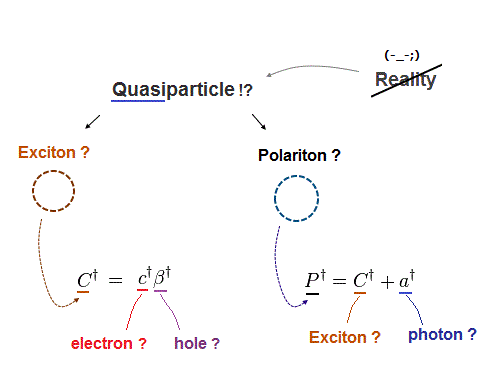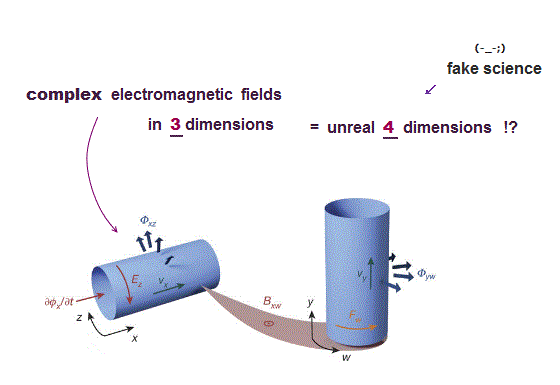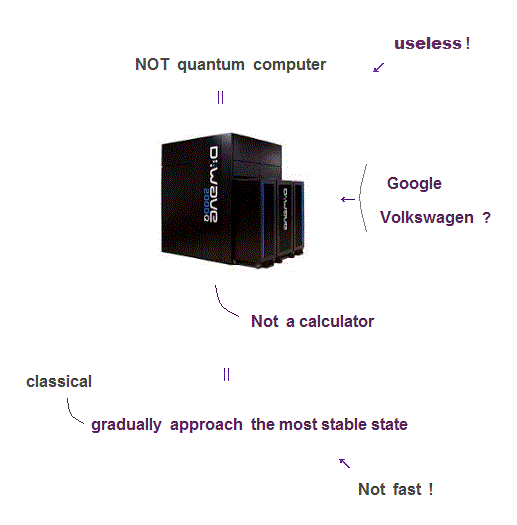
Home page
Quasiparticle is unreal
Fake Hawking radiation
Unreal exciton-polariton quasiparticle
(Fig.1) Quantum mechanics can only describe an electron (+ a hole ) transiently excited by laser light as unreal polariton (= unreal excition quasiparticle + a photon ) quasiparticle model, which is useless for any technologies.

The present unphysical quantum mechanical researches have wasted time only in illuminating various materials by light and trying to explain their response to light as fictional polariton quasiparticle model consisting of another fictional exciton quasiparticle (= a fictional particle representing an electron and a hole transiently excited by light ) and a photon (= light ).
↑ This fictional old quantum mechanical polariton quasiparticle model introduced in 1956, which is expressed only as unphysical math symbols ( this-p.3-(4), this-p.3-(15) ) lacking real particle shape, has been useless for any technology and unable to clarify real physical mechanism based on real particles.
(Fig.O) Useless quantum mechanical polariton quasiparticle model needs fake news.

To hide the inconvenient fact that the current fictional quantum mechanical quasiparticle models have hampered science, an incredible amount of overhyped fake news tries to connect the useless polariton quasiparticle with imaginary application such as polariton laser, transistors, neuromorphic and quantum computers.
The 13-14th, last paragraphs of this overhyped news (5/29/2025) say
" The electrons in the material are excited by the incident light and coupled to the light particles (= photons )."
"Experts call these hybrid light-matter particles exciton-polaritons (= fictional quasiparticle )"
"Potential (= meaning "still unrealized" ) applications include, for example, fast optical switches, neuromorphic computing, so-called polariton lasers,"
↑ This research paper ↓
p.1-abstract says nothing about any practical use such as fast switches, neuromorphic computing, laser (= so this polariton quasiparticle research is useless ), contrary to the above hyped news.
p.9 says this research used optical spectroscopy just measuring how incident light was absorbed or re-emitted by material ( this-p.2 ) to imagine (= Not directly see ) fictional exciton-polariton quasiparticles.
p.9-right says this research relied on artificial exciton-polariton quasiparticle model and freely-fitting interaction parameters γ, g (= allegedly representing electrons transiently excited by incident light ) with No quantum mechanical prediction ( this-p.10-11 ).
The 6th-paragraph of this overhyped news (4/17/2025) says
"Polaritons, also known as hybrid light-matter states,... which could (= just speculation, still useless ) enable faster and more energy-efficient quantum computing and communication technologies" ← hype
↑ This research paper's p.1-abstract says nothing about any practical use such as quantum computing and communication, contrary to the above hyped news.
In this way, there is a wide discrepancy between the overhyped fake science news and the actual research paper.
(Fig.2) All optical logic gate based on fictional polariton quasiparticle transiently excited by input light is impractical for a computer forever.

This-How do you store data optically ? (6/13/2024) says
"another important challenge is optical data storage—you can't simply stop light from propagating to store its data."
"The greatest challenge is developing large optical memory, analogous to the dynamic random access memory in electronic computers, as it’s hard to confine light and store it for longer"
↑ Unlike the present practical computers with the compact stable electrically-driven transistors and memory, the dreamlike all-optical computers using only fragile light can Not confine or store light, which is always flying at the fastest speed, in stationary memory, so impractical forever.
The 2nd, 3rd paragraphs of this say
"The most obvious challenge with optical computers lies in their currently high cost and low-to-middling performance"
"optical fibers are relatively large when compared to electrical traces. After all, transistors have been developed well into the nanometer scale, while visible light is on the scale of hundreds of nanometers. Additionally, the size of transistors is much smaller than the optical crystals utilized in many optical transistor designs. Furthermore,.. their long-term data reliability is currently unproven,"
(Fig.T) Overhyped fake news tries to connect the useless unreal polariton quasiparticle model to fake target = optical computer or transistors.

The last paragraph of this overhyped news (4/30/2025) says
"The results of the study are another important step (= still unrealized ) toward the creation of optical computers that can work hundreds of times faster than traditional computers."
↑ This research paper ↓
p.4-right-last-paragraph just vaguely says "we predict sub-THz bandwidth as the upper limit for the operation of polariton transistors, signifying the importance for future progress (= talk about uncertain future, still unrealized )"
p.6~p.9 shows the research just used fictional exciton-polariton quasiparticle model and artificially-chosen parameters to simulate the impractical bulky optic logic gate without quantum mechanical prediction.
The 3rd paragraph of this other overhyped news (7/25/2024) by the same team as this says
"The results of this study bring scientists closer (= still unrealized ) to the long-held dream of creating optical computers" ← hype
↑ In this research, they illuminated some material with pump laser light (= transiently exciting fictional exciton-polariton quasiparticles ? ), which emitted output light (= 1 ) or not (= 0 ), depending on additional input seed lights (= optical logic gate ? ), which is treated as (impractical) optical NOR gate ( this-p.2-4 ).
↑ Just measuring light with No storage memory in useless polariton transistors.
↑ Making a single bulky impractical optical gate or transistor (= one gate's size is too bulky = one light spot > 26μm + 50mm big optical lens far bigger than the ordinary non-optical transistor of less than 50nm, this-p.5-right-spectroscopy ) alone lacking storing memory can Not realize practical optical computers that will need (illusory) memories storing the flying light for a long time, which is impossible to realize forever.
(Fig.3) Fictional polariton laser is unstable, impractical forever, contrary to hypes.

The invention of laser was irrelevant to quantum mechanical theoretical prediction, as shown in the fact that the first laser made by Maiman in 1960 was rejected by academic journal Physical review ( this-p.2 ), and its unexpected discovery surprised physicists at the time ( this-p.7 ).
The 2nd, 5th, 5th-last paragraphs of this overhyped news (5/21/2013) say
"The physics powering lasers, however, has remained relatively unchanged through 50 years of use (= No progress in laser technology for 50 years due to useless quantum mechanics ). Now, has demonstrated a revolutionary electrically driven (fictional quasiparticle) polariton laser that could (= just speculation ) significantly improve the efficiency of lasers."
"Electrically driven polariton lasers would operate using one-hundredth of the power of conventional lasers and could one day (= still unrealized ) be used in many places from consumer goods to quantum computers (= imaginary target )."
"The current polariton laser can run only at a chilly 4 degrees Kelvin (minus 452 degrees Fahrenheit) and requires constant cooling" ← Polariton laser needing cryogenic temperature is impractical, far from energy efficient.
↑ To invent new (polariton) laser, physicists paradoxically try to rely on fictional polariton quasiparticle model that was introduced in 1950s, which is older than the conventional laser
The 1st-paragraph of this recent news (6/18/2024) paradoxically says
"Exciton-polariton lasers, renowned for their low-power operation, have long tantalized researchers with their promise (= still unrealized ) for practical low-energy applications. However, until now, a clean measurement of the laser's linewidth, or spectral purity, has remained elusive."
This article's p.9-2nd-paragraph & p.10-2nd-paragraph in 2024 say
"Polariton laser has high fluctuation in intensity therefore low coherence and for which it
is difficult to control its thermal stability.. This is one of
the difficulties of the development of polariton laser"
"But still it is difficult to make a real polariton laser experimentally" ← still No practical polariton laser contrary to the above hyped news ( this-p.61(or p.42)-last-paragraph ).
This latest polariton-laser research's p.3-left-2nd-paragraph in 2025 says
"the single-crystal perovskite microcavities were pumped off resonance using a 405-nm CW diode laser" ← So this polariton laser was excited by laser light, Not electrically-driven ( this-2nd-paragraph ), which is Not a practical laser.
" The perovskite lasers show decent operational lifetimes (T50) of ~6.4 hours under continuous pumping"
↑ This pervoskite used for the latest polarison laser has too short lifetime of only 6.4 hours ( this-p.15 ), which is completely impractical.
This-6th-paragraph (3/7/2024) says
"there are several challenges, for example low exciton binding energy, environmental stability, and formation of trap states at the vicinity of grain interfaces, that need to be addressed when considering perovskite use in lasers."
The 5th paragraph of this hyped news (5/13/2025) says
"Polariton (= fictional quasiparticle ) microcavities (= confining light by two reflecting mirrors ) are fundamental for understanding the interactions between light and matter. Moreover, they are crucial for emerging technologies, including ultra-efficient lasers, quantum optics, and next-generation screens."
↑ This research's abstract says nothing about "ultra-efficient" laser, contrary to the above hyped news.
(Fig.T) Quantum mechanical research is impractical with unreal quasiparticle model.

The 1st, 5th, 6th, 3rd-last paragraphs of this hyped news (9/3/2025) say
"Polaritons are quasiparticles (= unreal particles ) emerging from strong interactions between light particles (i.e., photons) and matter excitations (e.g., excitons). "
"Their study could open new exciting possibilities (= still unrealized ) for the engineering of many chemistry-driven devices, including solar cells, photocatalysts," ← fake news
"During the charge transfer reaction, the process that the team tried to realize utilizing polaritons, electrons move from one molecule (i.e., the donor) to another (i.e., the acceptor)."
"It turns out that it is very difficult to harness energy from polaritons,.. They want to release energy very quickly" ← No practical use
↑ This research paper ↓
p.1-abstract says nothing about any practical use such as solar cells, contrary to the above fake news.
p.5-Fig.4-(a),(f) shows this experiment just illuminated some material with pump laser that transiently excited electrons = fictional polariton quasiparticle whose lifetime was too short (= less than 400 fs =useless ), which was detected by probe light (= Not directly see unreal polariton ).
p.7-right-conclusion also says nothing about any practical use such as solar cells, contrary to the above hyped news.
↑ As shown here, today's impractical quantum mechanical researches based on fictional quasiparticles needs fake news hyping illusory application such as solar cells..

Feel free to link to this site.